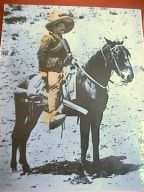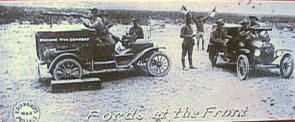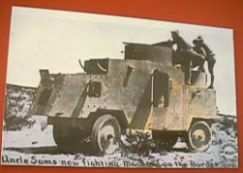Columbus NM Historical Museum
&
Pancho Villa State Park
SR-11 & SR-9
Columbus, NM
March 03, 2005
While staying in Deming, NM, we saw information about the
Columbus Historical Museum and the Pancho Villa State Park just a little over 30
miles south. As we came into town we saw the old railroad station that was
turned into the Columbus Historical Museum and
across the street was the Pancho Villa State Park. We chose to visit the
Historical Museum first. They had done a very nice job in the museum exhibiting
various items of historical interest donated by local residents.
in Deming, NM, we saw information about the
Columbus Historical Museum and the Pancho Villa State Park just a little over 30
miles south. As we came into town we saw the old railroad station that was
turned into the Columbus Historical Museum and
across the street was the Pancho Villa State Park. We chose to visit the
Historical Museum first. They had done a very nice job in the museum exhibiting
various items of historical interest donated by local residents.
We learned the story about the tragic fate of the small town that we were in.
The story went that in the early morning darkness of March 9, 1916, Mexican revolutionary Pancho Villa and some 500 guerrillas attacked the small New Mexico border town and military camp at Columbus. The
raiders approached from the southwest, moving around Cootes Hill in what is now Pancho Villa State Park. They left their horses near the hill and went on foot past the Custom House into the streets of Columbus. The Villistas began shooting wildly and setting fire to
buildings, taking the sleeping townspeople and some 350 troops of the 13th Cavalry completely by surprise. The bewildered soldiers at Camp Furlong were defenseless and had to break into the locked armory to get their weapons.
Lt. John Lucas, commander of the Machine Gun Toop, rallied his gunners, and other soldiers soon joined the battle. The army's machine guns jammed at first, but once they were brought into action, the Villistas were caught in a murderous crossfire, and the tide of the battle was turned.
After two hours of heavy fighting, the raiders began to withdraw. Shortly after dawn it was all over. Daylight found the center of Columbus a smoking ruin as news of
began shooting wildly and setting fire to
buildings, taking the sleeping townspeople and some 350 troops of the 13th Cavalry completely by surprise. The bewildered soldiers at Camp Furlong were defenseless and had to break into the locked armory to get their weapons.
Lt. John Lucas, commander of the Machine Gun Toop, rallied his gunners, and other soldiers soon joined the battle. The army's machine guns jammed at first, but once they were brought into action, the Villistas were caught in a murderous crossfire, and the tide of the battle was turned.
After two hours of heavy fighting, the raiders began to withdraw. Shortly after dawn it was all over. Daylight found the center of Columbus a smoking ruin as news of
 the arrack, flashed by telegraph, made newspaper headlines throughout the country.
the arrack, flashed by telegraph, made newspaper headlines throughout the country.
The Columbus Raid took 108 lives. Eight soldiers died in the fighting and their caskets were ceremoniously shipped home. Ten U.S. civilians were also killed, along with 90 Mexican raiders. The
soldiers hauled the dead villistas to the east of town and burned the bodies with oak wood and coal oil.
The violence that struck Columbus on March 9, 1916, was not an isolated event. It was rooted in the turmoil of the Mexican`
Revolution that had begun in 1910 when the Mexican people rose to end 34 years of
oppressive dictatorship under President Porfirio Diaz. For a decade, Mexico was ravaged by this social and political upheaval in which Francisco "Pancho" Villa played a major role.
Villa - whose real name was Doroteo Arango - was born in 1878, the son of a sharecropper, and his family suffered under the Diaz regime. Outlawed as a teenager, he assumed the name of a famous 19th-century bandit named Pancho Villa. The outlaw life sharpened Villa's natural abilities as a leader and guerrilla fighter, and when the Mexican Revolution exploded, he rallied to the cause of Francisco
Madero. Villa fashioned his guerrilla followers into the most awesome striking force of the Revolution. The former bandit and cattle rustler rose
to the rank of General, and became one of the most powerful leaders of the Mexican Revolution.
By 1914, the year of his greatest successes, Villa was the master of northern Mexico. He was then buying millions of dollars worth of merchandise from the United States and was considered a friend by Americans. Villa was even
on cordial terms with General John "Black Jack" Pershing, who later became his adversary.
In less than two years, all this changed and President Woodrow Wilson came to regard a rival;
regime. Outlawed as a teenager, he assumed the name of a famous 19th-century bandit named Pancho Villa. The outlaw life sharpened Villa's natural abilities as a leader and guerrilla fighter, and when the Mexican Revolution exploded, he rallied to the cause of Francisco
Madero. Villa fashioned his guerrilla followers into the most awesome striking force of the Revolution. The former bandit and cattle rustler rose
to the rank of General, and became one of the most powerful leaders of the Mexican Revolution.
By 1914, the year of his greatest successes, Villa was the master of northern Mexico. He was then buying millions of dollars worth of merchandise from the United States and was considered a friend by Americans. Villa was even
on cordial terms with General John "Black Jack" Pershing, who later became his adversary.
In less than two years, all this changed and President Woodrow Wilson came to regard a rival;
 Venustiano Carranza, as the official representative of Mexico. This enraged Villa and set the stage for the infamous raid on Columbus in March, 1916.
Pancho Villa was a staunch supporter of Francisco Madero, who became President of Mexico in 1911, after the overthrow of Porfirio Diaz. Madero's assassination 16 months later plunged Mexico into a long and bitter struggle, as numerous revolutionary factions raised troops and fought for control of the country.
Pancho Villa's archrival for leadership in northern Mexico was Venustiano Carranza. In 1915 Villa suffered a
series of disastrous defeats by Carranza's forces. As a result, the United States Government came to recognize Carranza as the official leader of Mexico greatly
angering Villa, the former favorite of the United States.
During the Mexican Revolution, whole families went to war. Women, called
Venustiano Carranza, as the official representative of Mexico. This enraged Villa and set the stage for the infamous raid on Columbus in March, 1916.
Pancho Villa was a staunch supporter of Francisco Madero, who became President of Mexico in 1911, after the overthrow of Porfirio Diaz. Madero's assassination 16 months later plunged Mexico into a long and bitter struggle, as numerous revolutionary factions raised troops and fought for control of the country.
Pancho Villa's archrival for leadership in northern Mexico was Venustiano Carranza. In 1915 Villa suffered a
series of disastrous defeats by Carranza's forces. As a result, the United States Government came to recognize Carranza as the official leader of Mexico greatly
angering Villa, the former favorite of the United States.
During the Mexican Revolution, whole families went to war. Women, called "soldaderas," foraged for food, cared for the wounded, and often took part in the fighting. The popular revolutionary song "Adelta" celebrated their role.
Trains became weapons of war--freight cars carried soldiers, cabooses were used as command posts, and locomotives ripped up tracks to block pursuit.
Immediately following the raid, troops from military bases throughout the Southwest converged on Columbus, preparing to pursue Pancho Villa into
Mexico. Newton Baker, Secretary of War under President Woodrow Wilson, ordered General John Pershing and his men to cross the border into Mexico to capture Villa and disperse his followers.
Reinforcements came by train, bringing horses, wagons, artillary, and supplies necessary for the expedition. The buildup continued
for days, swelling the small Columbus border patrol garrison. As the advance base for the Punitive Expedition, Columbus prospered. A steady stream of trucks and wagon trains moved south from the town,
"soldaderas," foraged for food, cared for the wounded, and often took part in the fighting. The popular revolutionary song "Adelta" celebrated their role.
Trains became weapons of war--freight cars carried soldiers, cabooses were used as command posts, and locomotives ripped up tracks to block pursuit.
Immediately following the raid, troops from military bases throughout the Southwest converged on Columbus, preparing to pursue Pancho Villa into
Mexico. Newton Baker, Secretary of War under President Woodrow Wilson, ordered General John Pershing and his men to cross the border into Mexico to capture Villa and disperse his followers.
Reinforcements came by train, bringing horses, wagons, artillary, and supplies necessary for the expedition. The buildup continued
for days, swelling the small Columbus border patrol garrison. As the advance base for the Punitive Expedition, Columbus prospered. A steady stream of trucks and wagon trains moved south from the town,
 maintaining Pershing's line of supply.
The Punitive Expedition, led by General John Pershing, marched south from Columbus on March 16, 1916, a week after Villa's attack. For 11 months the 10,000 men of the Punitive Expedition endured sandstorms, parching heat, and bone chilling cold as they ranged the wild deserts and mountains of the vast Mexican state of Chihuahua, tracking the Villista raiders.
The search for Villa ultimately led American troops some 500 miles into Mexico, as far south as the city of
Parral. Deep in Mexico, the Punitive Expedition clashed a dozen times with hostile Mexican forces, bringing the United States and Mexico to the brink of full-scale war.
The U.S. Army captured some of the Villistas who had been involved in the Columbus Raid, but Pancho Villa, the wily guerrilla chieftain,
maintaining Pershing's line of supply.
The Punitive Expedition, led by General John Pershing, marched south from Columbus on March 16, 1916, a week after Villa's attack. For 11 months the 10,000 men of the Punitive Expedition endured sandstorms, parching heat, and bone chilling cold as they ranged the wild deserts and mountains of the vast Mexican state of Chihuahua, tracking the Villista raiders.
The search for Villa ultimately led American troops some 500 miles into Mexico, as far south as the city of
Parral. Deep in Mexico, the Punitive Expedition clashed a dozen times with hostile Mexican forces, bringing the United States and Mexico to the brink of full-scale war.
The U.S. Army captured some of the Villistas who had been involved in the Columbus Raid, but Pancho Villa, the wily guerrilla chieftain, was never caught.
The Punitive Expedition was the last true cavalry action mounted by the U.S. Army, and it also marked the first U.S. Military operation to employ motorized vehicles. In what would prove to be a preparation for World War I, Pershing experimented in Mexico with the use of trucks and airplanes, though fuel for these new-fangled machines often had to be carried on pack mules.
For the first time, airplanes were used for reconnaissance and courier duty, Columbus became the first U.S. Army airbase for places used in combat conditions.
Although Pancho Villa was never captured, the Punitive Expedition did succeed in scattering the Villista forces that had attacked Columbus. Pershing perfected new
techniques of modern warfare an produced a seasoned battle force that would prove to be formidable during World War I in Europe.
was never caught.
The Punitive Expedition was the last true cavalry action mounted by the U.S. Army, and it also marked the first U.S. Military operation to employ motorized vehicles. In what would prove to be a preparation for World War I, Pershing experimented in Mexico with the use of trucks and airplanes, though fuel for these new-fangled machines often had to be carried on pack mules.
For the first time, airplanes were used for reconnaissance and courier duty, Columbus became the first U.S. Army airbase for places used in combat conditions.
Although Pancho Villa was never captured, the Punitive Expedition did succeed in scattering the Villista forces that had attacked Columbus. Pershing perfected new
techniques of modern warfare an produced a seasoned battle force that would prove to be formidable during World War I in Europe.
After we left the museum we went over to the Pancho Villla State Park and
visited Camp Furlong, including the adobe rums of the judge advocate's office a
jail, and Lt. Lucas' quarters. I thought it was interesting that they named the
State Park after the man who destroyed the town. The exhibit part of the park
was interesting but it also included a beautiful campground, a botanical garden,
and lots of nature trails.
Good Luck! Have Fun! and Stay Safe!
Laura